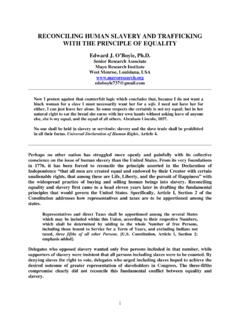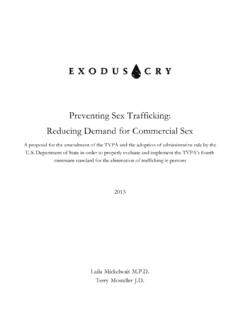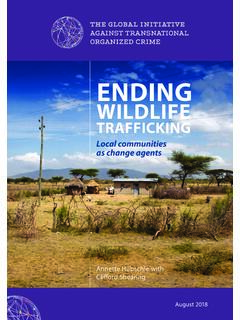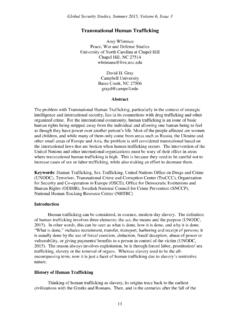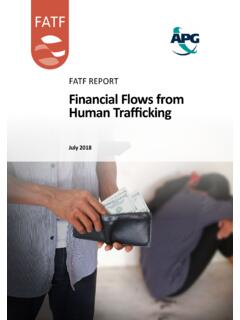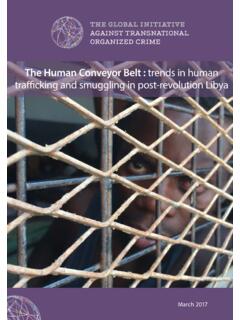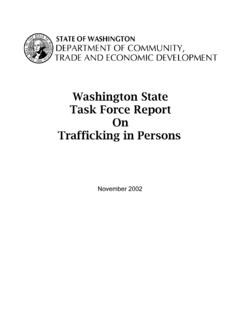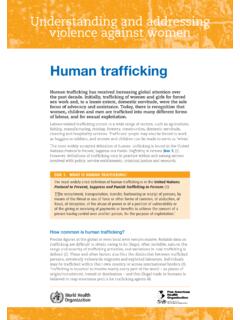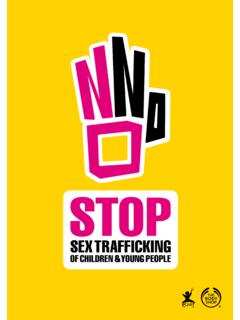Transcription of Human Trafficking: A Brief Overview - World Bank
1 1 No. 122 / December 2009 Human trafficking : A Brief Overview Introduction Millions of men, women and children are victims of Human trafficking for sexual, forced labor and other forms of exploitation worldwide. The Human and economic costs of this take an immense toll on individuals and communities. By conservative estimates, the cost of trafficking in terms of underpayment of wages and recruiting fees is over $20 The costs to Human capital are probably impossible to quantify. The problem of trafficking cuts across a range of development issues, from poverty to social inclusion, to justice and rule of law issues, and thus has relevance for practitioners throughout the development community.
2 This note provides a Brief Overview on the issues of Human trafficking , which can be used as a quick reference for the task team leaders, sector managers, directors, and their clients at the World Bank Group. This note will first provide a definition of Human trafficking and the scope of the problem, then summarize the regional trends of trafficking patterns. This is followed by a discussion of the key actors in the anti- trafficking movement and the role played by development partners in preventing Human trafficking . The final section offers some potential orientations for the World Bank Group to further engage this issue in its operations.
3 What is Human trafficking ? Human trafficking is a process of people being recruited in their community and country of origin and transported to the destination where they are being exploited for purposes of forced labor, prostitution, domestic servitude, and other forms of exploitation. The internationally recognized definition of trafficking is set forth in the Protocol to Prevent, Suppress and Punish trafficking in Persons, especially Women and Children2 (the Palermo Protocol), which supplements the United Nations Convention against Transnational Organized (a) trafficking in persons shall mean the recruitment, transportation, transfer, harbouring or receipt of persons, by means of the threat or use of force or other forms of coercion, of abduction, of fraud, of deception, of the abuse of power or of a position of vulnerability or of the giving or receiving of payments or benefits to achieve the consent of a person having control over another person, for the purpose of exploitation.
4 Exploitation shall include, at a minimum, the exploitation of the prostitution of others or other forms of sexual exploitation, forced labour or services, slavery or practices similar to slavery, servitude or the removal of organs; (b) The consent of the victim of trafficking in persons to the intended exploitation set forth in the subparagraph (a) of this article shall be irrelevant where any of the means set forth in subparagraph (a) have been used; (c) The recruitment, transportation, transfer, harboring, or receipt of a child for the purpose of exploitation shall be considered trafficking in persons even if this does not involve any of the means set forth; and 2 (d) Child means any person under the age of 18.
5 The United Nations Office on Drugs and Crime (UNODC) as the secretariat of the Conference of the Parties to the United Nations Convention against Transnational Organized Crime and its protocols, defines three basic elements of trafficking : first, the process; second, the means; and third, the purpose (see Table 1). UNODC explains that the crime of trafficking be defined through a combination of the three constituent elements and not the individual components, though in some cases threes individual elements will constitute criminal offences independently. 4 The individual elements, such as sexual exploitation, forced labor, slavery-like practice, are not further defined in the Protocol, and signatory states are obligated to further define these terms under their domestic The Palermo Protocol represents a broad international consensus on the definition of Human trafficking ; however there is controversy surrounding some of its elements.
6 The definition is broad and unclear, therefore it leaves interpretation to each State and generates various debates surrounding the definition. The International Labour Organization (ILO) notes that for example, there has been a debate as to whether trafficking must involve some movement of the trafficked victims either within or across national borders together with the process of recruitment, or whether the focus should be only on the exploitation that occurs at the end6. A further issue has been whether trafficking for the purpose of exploitation necessarily involved coercion. The Palermo Protocol Articles 3(b) and (c) addresses the question of The consent of the trafficked persons becomes irrelevant where any of the means ( force or coercion) described in the Palermo Protocol are present.
7 In the case of child victims of trafficking , the consent is irrelevant regardless of the means used. The trafficking in Persons report (TIP report ) 2009 published by the United States Department of State illustrates misconceptions held by some authorities regarding the consent of the victims and strongly expresses that even though a person may willingly agree to migrate legally or illegally or willingly take a job, once a person s work is recruited or compelled by the use or threat of physical violence or the abuse or threatened abuse of the legal process, the person s previous consent or effort to obtain employment with the trafficker becomes irrelevant.
8 8 Traffickers use a variety of methods to create a vulnerable condition for the victims so that the victims do not have any other choice but obey the traffickers. One of the common methods used by traffickers is debt-bondage in which the traffickers tell their victims that they owe money relating to their travel and living expenses and that they will not be released until the debt has been repaid. Traffickers also use other methods including starvation, imprisonment, physical abuse (beatings and rape), verbal abuse, removal of victims Table 1: Identification of Human trafficking (Process, Means, Purpose) Process MeansPurpose Recruitment Transportation Transfer Harbouring Receipt of persons Threat Force Coercion Abduction Fraud Deception Abuse of power Abuse of vulnerability Giving and receiving of payments Exploitation which includes: a) Prostitution and other forms of sexual exploitation b) Forced labor and services c) Slavery and similar practices d) Involuntary servitude e) Removal of organs Source.
9 UNODC (This table was shown in the PowerPoint presentation given at the global report on trafficking in Persons launch event at Foreign Correspondents Club of Thailand on February 13, 2009. report /PPT%20 TIP%205%20GB%20gl%20(13%20 Feb%2009).pdf ) 3 identification documents ( passport), threats of violence to the victims and the victims families, and forced drug use. Especially in the case of cross-border trafficking , victims often do not speak the local language or do not have any social network to assist them so that they are depending on members of their own ethnic group receiving them in the destination country. Furthermore, victims illegal status makes it difficult for them to seek help from law enforcement, the healthcare system and/or other public services.
10 Differences Between Human trafficking and Migrant Smuggling Smuggling of migrants shall mean the procurement, in order to obtain, directly or indirectly, a financial or other material benefit, of the illegal entry of a person into a State Party of which the person is not a national or permanent resident. The Protocol against the Smuggling of Migrants by Land, Sea, and Air, Article 3(a)9 Human trafficking and migrant smuggling are often confused with each other. These differ in three key elements: movement across borders, consent, and the purpose of One of the main differences is that migrant smuggling necessarily involves the crossing of international borders. Human trafficking may involve the crossing of international borders but can also occur within the borders of one country as internal Human trafficking .










